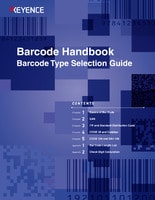EAN
About 100 types of barcodes are available in the world. The following is an introduction to EAN barcodes.
EAN Code and POS System
EAN Code
EAN is a standardized barcode and marked on most commercialized products currently available at the stores.
EAN is used in POS system that is widespread through the convenience stores.
EAN is compatible with UPC of U.S.A. and Canada and JAN of Japan. It is a universal code throughout the world.
EAN=European Article Number
UPC=Universal Product Code
JAN=Japan Article Number
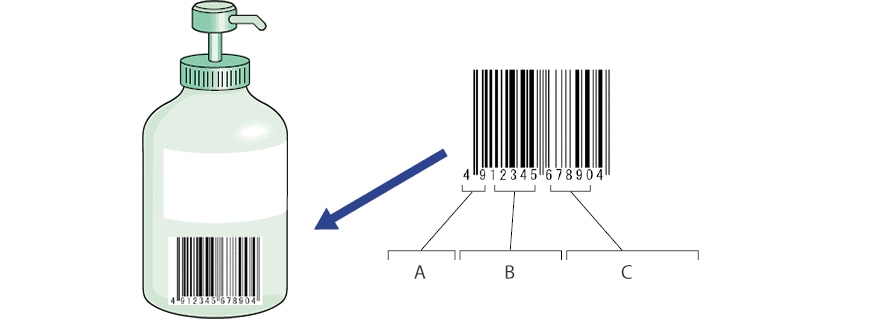
This is the unique code throughout the world.
POS System
This is a system used to manage sale, stock and purchase of commercial products by reading the EAN code of the products to be bought at supermarkets and convenience stores. As this system also provides accurate data of consumer trend, it contributes to deciding management strategies.

- A
- This item is 280YEN for sale.
- B
- Only 10 pieces are left in stock. Try to purchase 50 pieces.
- C
- Good sales have been enjoyed with this item. It’s a hot item.
- (1) Sales management
- (2) Stock and purchase management
- (3) Understanding consumer trend
(1) Sales management
Use of a barcode allows everybody to work on a cash register without any difficulty. The system supports workers who are not skilful with cash register operation, so that customers may not be forced to wait for a long time.
Counting the daily sales amount can be done instantly.
(2) Stock and purchase management
As the system provides information on real time basis on:
- Who bought the product?
- What time the product was bought?
- Which product was bought?
It is now possible to purchase the required product at the required time.
Since it is difficult for stores with limited spaces such as convenience stores to keep enough stock, it is very important for them to purchase the salable products in salable quantities. For the foods with expiration dates like box lunches, it is not allowed to display them for a long period of time. The system allows the arrangement to purchase at the required time in the required quantities.
(3) Understanding consumer trend
Any information can be collected on real time basis on:
- What is the most salable product?
- What customers are to be targeted?
- What is the least salable product on the other hand?
- What campaign brought the successful sale?
The information is very useful for deciding management strategies.
EAN Data Composition
Data Composition
EAN has the following data composition.
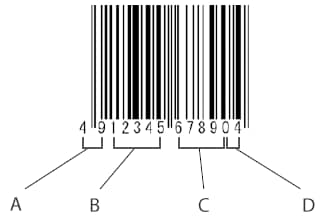
- A
- Country code [2 digits]
- B
- Manufacturer code [5 digits]
- C
- Product item code [5 digits]
- D
- Check digit
(1) Country code
Represents the country name.
(2) Manufacturer code
Represents the original seller's name.
Manufacturer code shall be applied for registration at the code center of each country in order to obtain it.
EAN code can be used only after the manufacturer code is obtained.
(3) Product item code
Identify the product. The manufacturer who obtained the product item code can make its own setting. The different product of the same manufacturer has the different product item code.
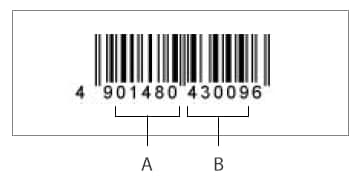
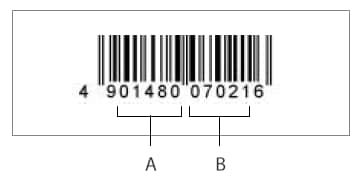
- A
- Manufacturer code
- B
- Product item code
Country code list
The number of member countries is 94 (92 code centers). (Note 1)
| Country code | Country name |
|---|---|
| 0~9 | U.S.A., Canada (Note 2) |
| 20~29 | In-store marking for retailers (Note 3) |
| 30~37 | France |
| 380 | Bulgaria |
| 383 | Slovenia |
| 385 | Croatia |
| 387 | Bosnia and Herzegovina |
| 400~440 | Germany |
| 45 + 49 | Japan |
| 460~469 | Russia and others |
| 471 | Taiwan |
| 474 | Estonia |
| 475 | Latvia |
| 476 | Azerbaidjan (Note 4) |
| 477 | Lithuania |
| 478 | Uzbekistan |
| 479 | Sri Lanka |
| 480 | Philippine |
| 481 | Belarus |
| 482 | Ukraine |
| 484 | Moldova |
| 485 | Armenia |
| 486 | Georgia |
| 487 | Kazakhstan |
| 489 | Hong Kong |
| 50 | U.K. |
| 520 | Greece |
| 528 | Lebanon |
| 529 | Cyprus |
| 531 | Macedonia |
| 535 | Malta |
| 539 | Ireland |
| 54 | Belgium, Luxembourg |
| 560 | Portuguese |
| 569 | Iceland |
| 57 | Denmark |
| 590 | Poland |
| 594 | Romania |
| 599 | Hungary |
| 600~601 | The Republic of South Africa |
| 609 | Mauritius |
| 611 | Morocco |
| 613 | Algeria |
| 619 | Tunisia |
| 621 | Syria |
| 622 | Egypt |
| 625 | Jordan |
| 626 | Iran |
| 628 | Saudi Arabia (Note 4) |
| 64 | Finland |
| 690~693 | |
| 70 | |
| 729 | |
| 73 | |
| 740 | |
| 741 | |
| 742 | |
| 743 | |
| 744 | |
| 745 | |
| 746 | |
| 750 | |
| 759 | |
| 76 | |
| 770 | |
| 773 | |
| 775 | |
| 777 | |
| 779 | |
| 780 | |
| 784 | |
| 786 | |
| 789 | |
| 80~83 | |
| 84 | |
| 850 | |
| 858 | |
| 859 | |
| 860 | |
| 867 | |
| 869 | |
| 87 | |
| 880 | |
| 885 | |
| 888 | |
| 890 | |
| 893 | |
| 899 | |
| 90~91 | |
| 93 | |
| 94 | |
| 955 | |
| 977 | |
| 978~979 | |
| 980 | |
| 981~982 | |
| 99 | |
| N/A (Note 5) |
(Note 1) EAN member countries do not include U.S.A. and Canada. The country code for the U.S.A. and Canada was changed from 00 to 13 in 2005.
(Note 2) UPC, unified product code of U.S.A. and Canada, is established in 1973. Other 94 countries (92 organizations) are the member countries of International EAN Association. The country code for the U.S.A. and Canada was changed from 00 to 13 in 2005.
(Note 3) The code center of each country defines its own usage. Used mainly for in-store marking of retailers.
(Note 4) New member country in 1999
(Note 5) New member country in 1999 (country code to be determined)
The manufacturer codes with 5 digits and 7 digits can be used in parallel since January 2001.
However, the following numbers will be assigned, so that the EAN code with the same number will never appear. (Table below is applicable only in Japan.)
As can be seen above, the first three digits make it possible to find whether the manufacturer code has 5 digits or 7 digits.
| Manufacturer code with 5 digits | 4900000~4999999 4500000~4599999 |
|---|---|
| Manufacturer code with 7 digits | 456000000~459999999 |
Source Marking and In-store Marking
Source marking
Source marking means that manufacturers or sellers print EAN codes on the product packages or containers during the production or packaging process. Most foods and daily necessities in supermarkets have source-marked EAN codes. As mentioned earlier, product item code registration is required to put source marking on the product.
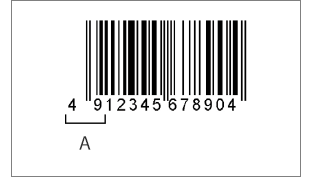
- A
- The source-marked bar code has “49” or “45”
In-store marking
Fresh foods (vegetables, meats, etc.) carry the labels where marking is arranged specifically by the individual supermarket, because the price depends on the weight of the individual product. This operation is called in-store marking, as it is available only in the store.
Since goods carrying in-store marking (e.g. vegetables) are sold only at that store, no manufacturer code is required and thus, any data composition is for the store's disposal. The price can also be included in the barcode. For the first two digits corresponding to EAN country code, however, it is ruled to use 20 to 29 to avoid any confusion.
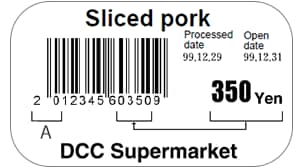
- A
- The barcode with in-store marking accepts the number of 20 to 29. Price can also be included in the barcode.
Applications in Other Industries
Source-marked barcodes for books and magazines adopt EAN barcode system, but have own data composition to meet the individual industry requirement. Information including prices is included in the barcode.
EAN Code of Books
Books have ISBN (International Standard Book Number) to classify each book.

- A
- Country code
- B
- Publisher code
- C
- Book code
- D
- Check digit
The barcode is formed with the classification code (classified by subject for sale, publishing source, content) and the price code (without tax) being combined with ISBN.

- A
- A flag (978) to identify ISBN
- B
- ISBN
- C
- A flag (192) to identify the classification code and the price code
- D
- Classification code
- E
- Price code
EAN Composition
EAN Composition (Details)
EAN codes include the following components:
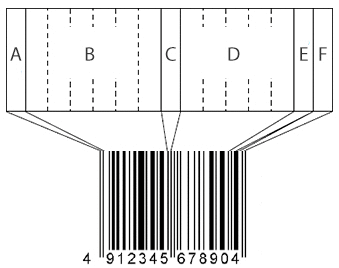
- A
- Left guard bar
- B
- Left character data (6 digits)
- C
- Center bar
- D
- Right character data (5 digits)
- E
- Check digit
- F
- Right guard bar
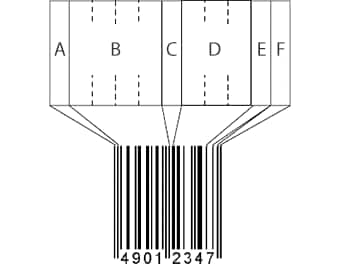
- A
- Left guard bar
- B
- Left character data (4 digits)
- C
- Center bar
- D
- Right character data (3 digits)
- E
- Check digit
- F
- Right guard bar
EAN does not use start/stop character, while it has a left guard bar on the left, a right guard bar on the right, and a center bar in the center of the barcode.
Other numbers are arranged in order.
As can be seen from the arrangement of the barcode above, the standard type has only 12 digits including the check digit. However, it actually represents 13 digits of data. For this, see here.
EAN Character Composition
EAN is composed of the following characters. At the right and left sides of the center bar, different bar patterns are used to represent numbers.
The bar patterns on the left side of the center bar have "odd parity" and "even parity".
| Character | Left odd parity | Left even parity | Right even parity |
|---|---|---|---|
| Bar pattern | Bar pattern | Bar pattern | |
| 0 |  |
 |
 |
| 1 |  |
 |
 |
| 2 |  |
 |
 |
| 3 |  |
 |
 |
| 4 |  |
 |
 |
| 5 |  |
 |
 |
| 6 |  |
 |
 |
| 7 |  |
 |
 |
| 8 |  |
 |
 |
| 9 |  |
 |
 |
| Left guard bar |  |
||
| Center bar |  |
||
| Right guard bar |  |
For the leftmost character (the first digit) in the standard type, it is determined by any combination of the odd and even parities of the 6 characters on the left side of the center bar.
The combination is as follows:
| First character | Combination of O and E |
|---|---|
| 0 | OOOOOO |
| 1 | OOEOEE |
| 2 | OOEEOE |
| 3 | OOEEEO |
| 4 | OEOOEE |
| 5 | OEEOOE |
| 6 | OEEEOO |
| 7 | OEOEOE |
| 8 | OEOEEO |
| 9 | OEEOEO |
In the short type (8 digits), all characters (4 digits) on the left side of the center bar are represented by odd parities.
Standard Size and Magnification
EAN defines specification for barcode size as below.
- The narrow bar width of the standard barcode is 0.33 mm.
- The standard barcode can be enlarged or reduced within the range of magnification ratio from 0.8 to 2.0. (The range for narrow bar width is from 0.26 to 0.66 mm.)
The following table shows the size of the barcode for each magnification. (For standard type [13 digits] barcode)
| Magnification | 0.8 | 1.0 | 1.2 | 2.0 |
|---|---|---|---|---|
| Narrow bar width | 0.264mm | 0.33mm | 0.396mm | 0.66mm |
| Barcode length | 29.83mm | 37.29mm | 44.75mm | 74.58mm |
| Barcode height | 18.29mm | 22.86mm | 27.43mm | 45.72mm |

- A
- Bar code length
- B
- Bar code height
Features of EAN Bar Composition
The EAN barcode composition has the following features:
- The EAN code uses 4 different bar widths, and high print quality is required. If the printers with low print quality, such as ink jet printers for FA and dot matrix printers, are used, the barcode reader cannot perform stable reading.
- The number of digits is fixed and users are not allowed to make their own data composition at their option.
UPC
What Is UPC?
UPC is a unified product code used in U.S.A and Canada. EAN of Europe and JAN of Japan are based on UPC.
UPC uses mainly UPC-A and UPC-E. UPC-A has 12 digits, while UPC-E has 8 digits.
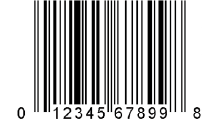
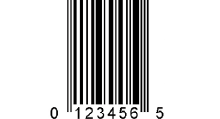
Number System Character and Data Composition of UPC-A
UPC-A is used only in U.S.A. and Canada, and it has no country code. Instead, the first digit, called number system character (NS), defines the contents of information.
The following is a summary of the typical data composition according to NS values:
| NS | Applications | Data composition |
|---|---|---|
| 0,6,7 | For source marking (same system as for EAN) |

|
| 1,8,9 | For source marking (same system as for EAN) |

|
| 2 | For in-store marking (weighing commodities) |

|
| 5 | For coupons |

|
C/D = Check digit
One Point
The manufacturer codes applied after March 20, 2000 are changed to 7 digits, the same as for EAN.


